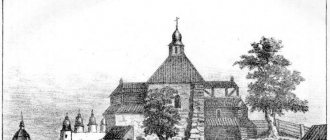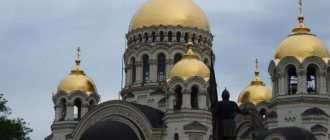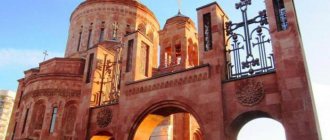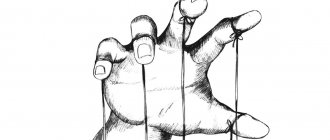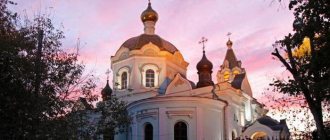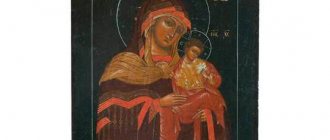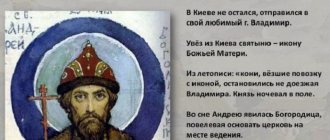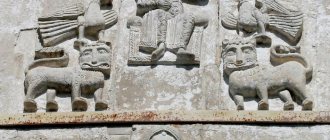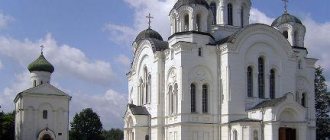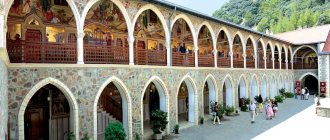Legend
The Church of the Deposition of the Robe (Moscow Kremlin) was consecrated by decree of the first Metropolitan of the Russian Orthodox Church, Jonah, in 1451 in memory of the miracle that occurred. This year, the Tatar hordes of Mazovsha stood near Moscow, the suburbs were already being destroyed by fire, and the walls of the Kremlin were besieged by enemy troops. The residents took up defensive positions, fought in hand-to-hand combat, falling under the enemy's arrows. While the battle was going on, Metropolitan Jonah made a religious procession around the walls of the city, earnestly praying for the salvation of Moscow from the invaders.
According to legend, during prayer Jonah met the ascetic of the Miracle Monastery Anthony and asked him to pray for the city and its inhabitants, to which the elder replied that Moscow would be saved by a miracle and that there would be only one killed in this battle - Anthony himself. Having said this, the elder immediately fell pierced by an arrow. By evening, the invaders retreated from the walls, and the residents and the metropolitan prayed all night, preparing for the decisive battle. When dawn broke, it turned out that the Tatar hordes had left the battlefield in a hurry, leaving behind all the loot.
What caused the flight is unknown; scientists believe that Mazovsha received some information, according to which he decided that it was useless to fight, or perhaps the entire army was seized with unaccountable fear, and, abandoning their prey, they withdrew from the battlefield. This fact has already happened under the walls of the Kremlin with the army of Batu Khan. Metropolitan Jonah believed that God’s miracle saved the city and country from destruction and murder.
Dream of a stone temple
According to some documents, the metropolitan courtyard on the Kremlin’s Cathedral Square took a long time to build. In the year of the Mazowsza invasion, the church was already built, but not consecrated. After the miraculous salvation, Jonah decided to consecrate the temple in honor of the holiday on which the salvation took place. This is how the Church of the Deposition of the Robe (Moscow Kremlin) appeared. The first building was wooden and stood on a high basement, where, according to ancient customs, the metropolitan's treasury and other valuables were kept.
The temple stood until 1479 and was destroyed in a big fire. They decided to revive the shrine in stone form, for which they invited craftsmen from Pskov, where the traditions of stone construction were preserved and flourished. The artel was headed by Ivan Krivtsov and Myshkin. The traditions of building stone houses at that time in Rus' had fallen into decline after centuries of dominance of the Tatar-Mongols - only craftsmen were found in Pskov.
They were instructed to build not only the Church of the Deposition of the Robe on Cathedral Square of the Moscow Kremlin, but also to build several cathedrals of a much larger scale. They installed one of them, Uspensky, but its roof collapsed. The chronicles say that “he was a great coward”; what led to the destruction is not clear today. The experts called in reported that the reason for this was a poor-quality mortar used for construction; how accurate the assessment was, history is silent.
History[edit]
The wooden temple was built in 1690 on the site of the solemn meeting of the Moscow clergy in 1625 of the embassy of the Persian Shah Abbas, who donated to Tsar Mikhail Fedorovich and Patriarch Philaret one of the most revered shrines of the Christian world - the Robe of the Lord, a piece of clothing in which Christ was led to Golgotha.
The chasuble was placed on a special altar under the canopy of the Assumption Cathedral of the Kremlin, a wooden temple was built at the meeting place, and later an obelisk, which has survived to this day. Since then, a new entry has appeared in the Russian church calendar: “The position of the honorable robe of our Lord Jesus Christ in Moscow (1625).” This holiday is celebrated by only one Orthodox Church - the Russian.
The stone church was built on the site of a wooden one in 1701-16. in the Moscow Baroque style. Among Moscow churches of the 17th-18th centuries. it stands out due to its slender quadruple proportions. completed with an attic and an expressive five-domed structure. In 1886-89. a chapel was built. Jacob Alfeev, and around 1894 the top of the bell tower was rebuilt. The interior of the church has retained its baroque stucco decoration. XVIII century, the wonderful baroque iconostasis dates back to the same time.
In the 20th century the temple did not close. In the 1930s, its rector was the holy martyr Alexander Khotovitsky. In 1944-1960, the cathedral housed the chair of Archbishop Macarius (Daev) of Mozhaisk; In 1949-1963, Archpriest Nikolai Golubtsov was a member of the church clergy. Since 2011, the honorary rector of the temple is Metropolitan Job (Tyvonyuk).
Pskov trace
So it happened that the Assumption Cathedral was built by the Italian architect Aristotle Fioravanti, summoned by Tsar Ivan III, and they nevertheless risked entrusting the further arrangement of the architectural ensemble to Myshkin and Krivtsov.
Through their efforts, the Annunciation Cathedral and the Church of the Deposition of the Robe (Moscow Kremlin) grew, which became the home church of the Russian patriarchs. It is believed that the Pskov masters, according to the law of their time, became students of the Italian architect and adopted all the knowledge from him, adding it to their own baggage. It is unknown what actually happened, there are only assumptions as to why the artisans were left unpunished and were entrusted with further construction, but this is how history turned out.
The Temple of the Deposition of the Robe in the Moscow Kremlin was consecrated in August 1486. The church was the home place of prayer for the patriarchs until the occupation of the church throne by Patriarch Nikon. In those days it was called the “domovaya Vladychna”, it was connected by internal passages to the patriarchal courtyard, having received the “installation”, the rulers of the church went out to the people through the vestibule of the Kremlin Church of the Deposition of Robes.
The temple-museum today houses a priceless collection of carved icons
In 1990, the Church of the Deposition of the Robe, as part of the architectural ensemble of the Kremlin, was included in the UNESCO list of World Cultural Heritage. The church building, which is made in exquisite proportions, as well as its internal stone decorations, are of real museum value.
In addition to the four-tier iconostasis, in the 17th century the famous master D. Sverchkov made a chandelier. And a little later, 4 wooden candlesticks were made. They are painted and covered with wax.
Today you can see restored 19th-century paintings above the ledges of the temple stairs.
In addition, in the northern part of the church there is an exhibition of carved wooden sculptures. These are works of Moscow, Pskov, Rostov and Novgorod masters of the 15th-19th centuries. The museum's collection includes more than 80 rare exhibits. It makes it possible to follow the development of this type of church art.
The carved wooden icon “Golgotha”, made by the masters of the Armory Chamber of the late 17th century, is on permanent display in the Church of the Deposition of Christ.
The Church of the Placing of the Robe of the Moscow Kremlin is an architectural monument of the second half of the 15th century and is protected by the state. You can visit it every day, except Thursdays, from 10.00 to 17.00.
Quite a lot of churches in memory of the Placing of the Robe have been built in Russia, but the church in the Moscow Kremlin is the most famous of them. It continues to be an example of the elegant solution of ancient architects in the construction of Orthodox church buildings.
By leaving a comment, you accept the user agreement
Temple painting
Compared to the rest of the buildings on the Kremlin’s Cathedral Square, today the temple looks miniature and light, but at the beginning of Orthodoxy in Rus' it was perhaps the main church of the entire country. The interior decoration is dedicated to the celebration and glorification of the Mother of God.
The frescoes of the upper level depict the life of the Virgin Mary, the two lower tiers are dedicated to the akathist of the Virgin Mary. The painting was carried out by the royal isographers Osipov and Borisov, and the main temple image “The Position of the Robe of the Mother of God” belongs to the brush of the famous icon painter Nazariy Istomin (17th century).
In the 17th century, the Church of the Deposition of the Robe (Moscow Kremlin) was adjoined on the south side by a chapel dedicated to the Pechersk Icon of the Mother of God, where a copy of the miraculous icon made in the Kiev Pechersk Lavra was kept. The icon was considered the protector of the Russian metropolis and accompanied the patriarchs of the church from Kyiv, first to Vladimir, and later to Moscow.
Royal House Church
In times of troubles, the patriarchal courtyard burned down, like many things during the fire. Nikon, who arrived, launched large-scale construction in the courtyard of Boris Godunov, given to him by Tsar Alexei Mikhailovich, where he equipped a new house church. So the Church of the Deposition of the Robe in the Kremlin passed to the royal family. It was connected to the chambers of the sovereign by a gallery, and the copy of the Pechersk Icon of the Mother of God after the construction of the Terem Palace ended up opposite the windows of the queen’s chambers. The list was lost after the revolution, along with the chapel, when large-scale restoration work was carried out.
The history of the Church of the Deposition of the Robe in the Moscow Kremlin is filled with many events; it has survived more than one fire, the most terrible of which happened in 1737, when even the Tsar Bell was damaged. In 1917, the Kremlin was shelled by artillery and the church was badly damaged. It was restored and restored as many times as it was destroyed, but more emphasis was placed on the external appearance; the internal paintings were repeatedly painted over and new ones were applied.
Temple of the Placing of the Robe - memory of the intercession of the Mother of God
In memory of this wonderful event - the intercession and patronage of the Mother of God against the invasion of the Tatar army, the Church of the Deposition of the Robe was erected in the Kremlin with the support of Metropolitan Jonah. First they built a wooden church. It burned down during a great fire in Moscow in 1473. Subsequently, when Metropolitan Gerontius was at the Moscow see, a grandiose reconstruction of the Moscow Kremlin began. For this purpose, craftsmen were hired from Pskov. In two years they built a stone church, completing the work by 1486.
For a long time, the Temple of the Deposition of the Robe served as a house church for Moscow metropolitans, and subsequently for Moscow patriarchs. In the middle of the 17th century, during the patriarchate of Nikon, another house church was built in memory of the Twelve Apostles, and the Church of the Deposition of the Robe began to be used by the royal family for private home prayer.
At the same time, the church was rebuilt, covered with a hipped roof, and vaults were erected over the porches. Along this gallery the royal family could move from the Terem Palace to the Assumption Cathedral.
Subsequently, the temple was severely destroyed twice more. During the fire in 1737 and after artillery shelling of Kremlin buildings in 1918. In both cases, the church was restored. But in Soviet times, although the temple was restored, it was forbidden to hold services in it. In 1965, a museum was opened in the church premises.
Architecture
Today, the Church of the Deposition of the Robe is located on Cathedral Square of the Moscow Kremlin in a not very favorable location, adjacent to the Faceted Chamber, the Terem Palace and the Assumption Cathedral. Against the background of these buildings, the church is almost invisible, and yet its age is much greater than that of other grandiose buildings.
The church belongs to the traditional cross-domed buildings. It is made of brick, which in the 15th century began to replace the white stone that was in great use. All four sides of the temple are divided into three parts; previously such a division was called spinning. The peculiarity is that the central spindle of the church is much larger than the two side ones. Above each section of the wall, a keel-shaped zakomara (vault), traditional for Russian architecture, rises as a completion. The altar projections on the outside are also divided into three semicircular parts.
The Church of the Deposition of the Robe in the Moscow Kremlin is a single-domed temple with a helmet-shaped dome, above which rises the light drum of the dome. The under-dome part of the drum is decorated with a special author's frieze ornament, referring to the Pskov northern school of Russian architecture. Decorations are made of bricks - a curb, a runner.
Decorations and details
The eastern part of the temple is accessible for inspection from Cathedral Square. The central apse of the altar wall is more noticeable than the two narrower side apses, which is due to the architectural structure of the cross-domed churches. Along the entire perimeter of the temple in the upper part there is a decorative frieze, which serves as a sign of Russian church architecture of the early period.
The facades in the lower part are decorated with semi-columns, which, connecting along the upper level, repeat the pattern of keel-shaped zakomaras. On three walls of the church there are shallow niches in which icons were previously displayed. Now only one fresco from the 17th century has been preserved on the northern facade; it was discovered during restoration work in 1996; it depicts the patronal feast of the temple - the Position of the Robe of the Blessed Virgin Mary.
Entrances to the Church of the Deposition of the Robe (Moscow Kremlin) are located on all sides. From the east and south you can get directly into the interior. The southern entrance is decorated with a keel-shaped portal and a high staircase, and the eastern one leads to the galleries of the tower palace. Entrances located on the western and northern sides of the temple lead the visitor to covered galleries.
Around the Church of the Deposition of the Robe
Church of the Deposition of the Robe. After we have carefully examined the external architectural features of the Assumption and Archangel Cathedrals of the Moscow Kremlin, we should get acquainted in no less detail with the external decoration of the small Church of the Deposition of the Robe. It looks more than modest compared to the Assumption Cathedral. And the temple is located in a very unfavorable place - in a tight corner between the Faceted Chamber, the Assumption Cathedral and the Terem Palace. But the architecture of the Church of the Deposition of the Robe is very interesting and, undoubtedly, worthy of a separate story.
At the end of the 15th century, grandiose work was underway in the Moscow Kremlin to rebuild its architectural ensemble. The Emperor invited to Moscow the best craftsmen that his entourage could find. The main role in creating the new look of the grand ducal residence was undoubtedly played by Italian architects. But Pskov craftsmen also worked in the Kremlin. It was they who were entrusted with the construction of the house church of the Russian metropolitans in 1484.
The following is a quote from I.M. Sokolova’s book “The Church of the Deposition of the Robe”, published by the Moscow Kremlin Institute of History and Culture: “Obviously, the Pskov masters were asked to use Moscow churches of the 15th century as a model, which explains the predominance of Moscow features in the architecture of the Church of the Deposition of the Robe.” Here an amateurish question arises about Moscow stone churches of the 15th century. What temples are we talking about? About the Transfiguration Cathedral of the Spaso-Andronikov Monastery? About the Trinity Cathedral of the Trinity-Sergius Lavra? Or in general about the church in the village of Kamensky? Let's leave the question about Moscow stone churches of the 15th century unanswered and return to the Church of the Deposition of the Robe.
The temple is traditional, cross-domed. It was built from brick; at the end of the 15th century in Moscow this building material replaced white stone everywhere. The walls of the temple on all sides have a three-part division. Do you remember what a separate section of the wall is called? That's right, a spinner. The southern wall of the temple, like other walls, is divided into three sections - a wide central one and two narrow side ones.
Each spindle ends with keel-shaped zakomaras. Zakomara is an important element of ancient Russian architecture. “ Zakomara ” comes from the word “komara”, which in the Old Russian language meant “vault”. (For a mosquito - behind the arch). Zakomara is the completion of the outer wall spindle. Zakomara reproduces the internal vault with its outlines. Zakomars can be semicircular, as on the Assumption Cathedral.
Spinning of the southern wall of the Assumption Cathedral. The spindle ends with a semicircular zakomara.
Or keel-shaped, as in the Annunciation Cathedral and the Church of the Deposition of the Robe.
Church of the Deposition of the Robe. South wall. The temple's zakomars are keel-shaped.
The apses, that is, the altar projections on the eastern side, also consist of three parts.
The temple stands on a high ground floor - basement.
The Church of the Deposition of the Robe is single-domed. It ends with a helmet-shaped dome. The dome is crowned with a high drum.
Church of the Deposition of the Robe. The picture shows a helmet-shaped dome, it stands on a high drum. To the left are numerous domes of the Verkhospassky Cathedral.
Let us note in parentheses that the helmet-shaped domes are shaped like ancient Russian shelom. The helmet-shaped dome is a symbol of the army, the spiritual battle waged by the Church with the forces of evil and darkness.
The drum of the Church of the Deposition of the Robe is placed on a faceted pedestal. Both the pedestal and the narrow arched windows of the drum are clearly visible in the bottom photo. The shape of the windows is emphasized with a roller the same as the window shape.
The photo shows that the drum cylinder “grows” from the faceted pedestal.
Let us pay attention to the decoration of the upper dome part of the drum. A frieze is laid along its entire circumference. The frieze consists of several rows of brick decorations.
Fragment of the drum of the central dome of the Church of the Deposition of the Robe
At the very top there is a roller, below there is a series of arches, even lower there is a curb , then a runner and again a curb . Curb - in architecture, a special decorative brickwork is called. A row of bricks is laid at an angle to the wall surface. A row of curbs looks like a corrugated belt.
The runner is also a special type of brickwork. The bricks are laid out obliquely and form triangles. The runner's triangles alternately point their vertices up and down. The runner gave his best with his belt. Simply put - a row of brick decorations in the form of triangles is called a runner. Decorating walls with runners and curbs was adopted in northern architecture, characteristic of Pskov and Novgorod. Pskov craftsmen left a kind of autograph on Moscow churches.
Table of contents
Church of the Deposition of the Robe. Eastern wall
Let's look at the eastern part of the temple. It is best seen from Cathedral Square. Let us pay attention to the fact that the central altar projection (apse) is noticeably wider than the side ones. This is an architectural feature of cross-domed churches. The apses are decorated with a decorative brick frieze. This detail is typical for early Moscow churches. The apses of the eastern wall are decorated with a belt of semi-columns. Arrow-shaped arches are thrown across the semi-columns. They harmoniously combine with keel-shaped mosquitoes.
Each arch rests on the capitals of semi-columns. The capitals are shaped like tied sheaves.
Above the keeled arches there is an interesting frieze belt with complex floral patterns.
The frieze ends with a series of stepped triangular niches separated by low columns with beads.
South wall of the Church of the Deposition of the Robe
You can enter the Church of the Deposition of the Robe from the south or east. At the southern entrance there is a high porch with steps leading up to it.
The portal of the southern entrance is decorated with a keel-shaped finish.
A decorative frieze runs across the entire width of the southern wall. Its motif almost repeats the frieze of the eastern wall. But from the east the row of niches has a triangular shape. On the south side it is diamond-shaped.
For comparison, here are two pictures.
Frieze of the southern wall Frieze of the eastern wall
In the upper part, under the central zakomara of the southern wall, there is a triple niche. In shape it resembles a triple folding icon. Apparently, there was a picturesque image in the niche. But no traces or documents about the plot of the painting have been preserved.
Please note that the central part of the fold is separated from the side by semi-columns with capitals in the form of tied sheaves. The half-columns in the center are decorated with beads.
North wall of the Church of the Deposition of the Robe
A late gallery adjoins the temple on the northern and western sides; it was added in the middle of the 17th century.
View of the Church of the Deposition of the Robe from the north side. The photo shows that the main quadrangle of the temple is closed by a later gallery.
There is a niche at the top in the middle of the north wall. The remains of 17th century painting are clearly visible in it. (The fresco was unveiled in 1996).
The fresco depicts the temple feast of “The Position of the Robe of the Most Holy Theotokos.”
Western wall of the Church of the Deposition of the Robe
Only a very meticulous visitor will pay attention to the western wall of the Church of the Deposition of the Robe. Let us count ourselves among those and look into the farthest corner. Let us note that the gallery added in the 17th century (we saw it from the north) is connected to the Terem Palace on the western side. Thus, from the palace through the covered gallery it was possible to get directly into the Church of the Deposition of the Robe without going outside.
On the western wall above the gallery another niche is visible. It was established that there was a fresco of the “Pechersk Mother of God” in it.
This image was very revered in Moscow. At one time, the Church of the Deposition of the Robe was called the Temple of Our Lady of the Pechersk; the Pechersk Chapel was even added to the church. In the 1930s-40s of the twentieth century, the temple was cleared of later additions, including the Pechersk Chapel. Then the image of the Pechersk Mother of God was lost forever.
We will not overload the article with details about the construction and numerous reconstructions of the temple. The purpose of this article was to talk about the modern architectural decoration of the Church of the Deposition of the Robe in the Moscow Kremlin. There will be a separate story about the temple holiday of the Placing of the Robe.
Let me briefly recall the history of the dedication of the temple to the Feast of the Placing of the Robe. The previous modern church, built in 1451(?) (burnt down in a fire in 1473), was built by order of the first independent Moscow Metropolitan Jonah (buried in the Assumption Cathedral) in honor of the miraculous deliverance of Moscow from the “imminent Tatarism.” In 1451, the troops of the Tatar prince Mazovsha approached Moscow. Grand Duke Vasily II the Dark was not in the city. (S.K. Romanyuk writes that he simply ran away, leaving Moscow to the mercy of fate). Muscovites repelled the first attack of the Tatars with their own forces. Metropolitan Jonah and the priests prayed for the intercession of the Most Holy Theotokos and walked around the walls of the white stone Kremlin in prayer. It was July 2, 1451. The next day, residents expected a new attack, people were preparing for battle. But in the morning it was discovered that the Tatar army had left the camp. Historians testify that Mazovsha decided to return to the Horde due to the difficult internal political situation. In Moscow, this event was regarded as a miracle, the intercession of the Most Holy Theotokos. On July 2 according to the old style (Julian calendar), on July 17 - according to modern chronology, the Orthodox Church celebrates the Feast of the Laying of the Holy Robe of the Blessed Virgin Mary - the Laying of the Robe.
Sources: I.M. Sokolova “Church of the Laying of the Robe”. GIKMZ “Moscow Kremlin”, 2002. S.K.Romanyuk “The Kremlin. Red Square". M, ANO IC “Moscow Studies”, OJSC “Moscow Textbooks”, 2004.
The article about the Church of the Deposition of the Robe is the third in a series of reports on the external architectural decoration of the churches of the Moscow Kremlin. Start in the article “Architectural analysis of the Archangel Cathedral”. Continuation: “External decoration of the Assumption Cathedral” Image of sovereigns in the Kremlin cathedrals.
We invite you to exclusive tours of Moscow: Guide in Moscow Excursions in Moscow and the Moscow region Walking tours in Moscow Private guide-translator in Moscow Moscow tour-guide Excursion to the Novodevichy Convent
Interior
The interior of the temple forms a single space, chamber in volume and designed for a small number of parishioners, as befits a house church. The vault rests on four columns. The space of walls and supports is covered with religious paintings.
The main part of the plots is dedicated to the Mother of God; the painting style is close to the frescoes of the Assumption Cathedral. The coincidence is not accidental: the work in 1644 was carried out by famous masters Sidor Pospeev and Semyon Abramov. The pillars depict Russian princes and metropolitans.
What 17th-century painting looks like became clear in 1956, when historical subjects were discovered and purified under later layers. During the same period, a complete restoration of the ancient iconostasis was carried out, which did not leave the Church of the Deposition of the Robe of the Moscow Kremlin. The description of the general composition of the painting and the iconostasis indicates that it was the basis for the color scheme of the painting.
Iconostasis
The iconostasis is made of silver, richly and skillfully decorated with ornaments. The inserted icons are painted in joyful, bright colors, where blue, cherry, and white colors predominate. The iconostasis was the first created after the Time of Troubles and the devastation that befell the country. The customer was the father of the first tsar from the Romanov family, Patriarch Filaret.
The top three rows of icons were painted by workers in the workshop of icon painter Nazariy Istomin Savin in 1627. The bottom row was painted by the master himself, two brushes belong to him, “Our Lady Hodegetria.”
Restoration work from the mid-50s confirms that the frescoes on the walls supported color combinations. The influence of earlier periods of Christianity, when Rus' was the metropolis of Byzantium, is noticeable in the pictorial design.
Majestic figures in the upper tiers and on the pillars, depicting the apostles and great princes, are adjacent to images in which the master, adhering to strict canons, expresses his respectful attitude towards the heroes of the frescoes and endows the atmosphere around them with joy and light.
Modernity
In the early 90s, the Church of the Deposition of the Robe was open to visitors, and on the days of the patronal temple holiday, services and liturgies are held here. Only a few utensils have survived. Large antique candlesticks are installed in front of the iconostasis; in the old days they were called “skinny candles” - hollow inside. The candlesticks were given to the temple as a gift by Patriarch Joseph in 1649. They are decorated with carvings, silvered bases and rest on stylized lion figurines. The second unique item from 1624 is a silver chandelier, covered with gilding, by the boilermaker D. Sverchkov.
It is worth coming to the temple to see the frescoes of the 16th century and visit the exhibition of wooden ancient Russian sculpture located in the covered gallery. One of the most ancient high reliefs depicting St. George from the 14th century greets the visitor right at the entrance to the exhibition. In the old days, similar works were inserted into the iconostasis and served as icons. Of great interest are the Novgorod icon “Descent from the Cross” and “Our Lady of the Sign” (Rostov).
In the Church of the Deposition of the Robe, on display, there is also a wooden sculpture of the first metropolitan of Rus' - Jonah, who founded the church in ancient times. On display are wooden icons of the Solovetsky Monastery, an image of Nicholas of Mozhaisk with a sword, in the image in which he appeared to defend the city of Mozhaisk from invaders. No less interesting are other rarities - a crucifix from the Chudov Monastery, folding objects, icons from the period of the 15th-19th centuries.
A little history
The cathedral was consecrated in honor of the great feast of the Placing of the Robe, established in the 5th century (in Byzantium). An important memorial day for Christians is associated with the acquisition of the Robe of the Virgin Mary (the clothing of the Mother of God). Initially, it was kept in the Temple of Constantinople, located on the coast of the Blachernae Gulf. Legends say that this shrine has repeatedly saved locals from enemy troops.
The Moscow Church of the Deposition of the Robe, which has survived to this day, was erected on the site of an older church of the same name, founded in the distant 15th century after the victory of brave warriors over the Tatars. It stood for exactly 34 years, after which it was demolished, deciding to begin construction of a new temple, a stone one. It is this version of the cathedral that is available for visiting by modern Orthodox Christians and tourists from different parts of Russia and other countries.
INTERESTING: Prayers to the Guardian Angel.
The stone Church of the Deposition of the Robe was erected on the initiative of Metropolitan Jonah, who planned to open a home for the Moscow metropolitans (eventually the patriarchs) in the Metropolitan Courtyard. The cathedral functioned successfully until the arrival of the Soviets, after which it was closed and stopped being used for organizing divine services. Since the mid-60s, the church has worked as a museum.
This was the case until 1993, when, after the collapse of the Soviet Union, the Russian Orthodox Church restored its right to hold liturgies, create parishes, etc. After the opening of the temple, divine services began to be held there again, including the patriarchal (a rare event that falls annually on July 15, Feast of the Placing of the Robe).

